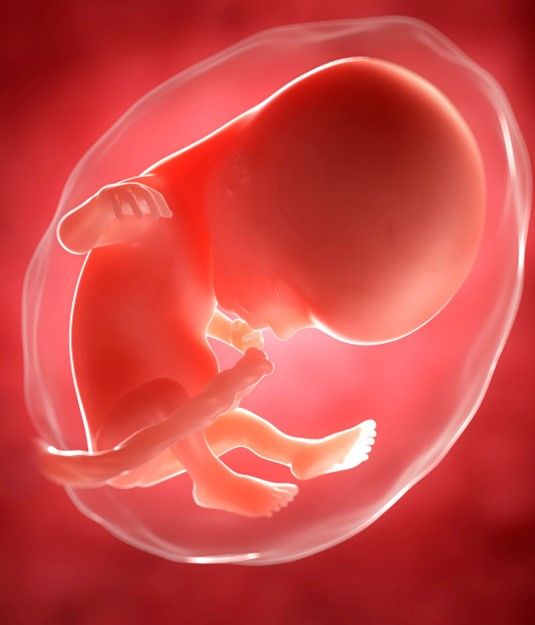- Your Baby is the size of a Large Brinjal now and weighs nearly 1.15kg!
The baby is putting on weight constantly and is well over 1kg.
250mg of calcium is deposited in the baby’s skeleton every day which is utilized by the teeth, muscles and heart, and nerves. Bones are hence getting harder.
TME Fact Check: Your baby needs extra calcium for all the bone development, so Mama, do not forget your calcium supplements & calcium-rich foods!
CHANGES IN ORGANS

Fetus at 28 weeks
- The iris muscles of the eye and the color and pattern are also developing. The color of the eye, however, will be known only post-birth.
- The nerves are also beginning to get encased within a waxy myelin sheath that protects the nerves, acts as a shock absorber, and permits fast transmission of signals. This process of myelination continues after birth too.
- Bone marrow starts producing red blood cells. Initially, this was done by the liver and spleen, but as the marrow is assuming its function, the liver and spleen no longer produce red cells at the same rate as before.
PREGNANCY SYMPTOMS IN MOTHER
- Baby’s kicks are increasing with every passing day!. As the uterus is growing to accommodate the baby, it will cause pressure on the diaphragm pushing the lungs upwards. This may lead you to have slight breathing difficulties.
TME Tips: Yoga and meditation helps with these breathing difficulties to a great extent mama! However, nothing much can be done about the symptoms caused by the growing uterus.
- You might start experiencing Braxton Hicks contractions, where the uterus tightens for a few seconds and then relaxes. *ouch*
TME Tips: These are false contractions and you need not be worried. Relax, sip water, and lie down for a bit to ease these contractions.
- Itching is also common this week. Itching can increase chances of stretch marks, so it is very important to resist the urge to itch.
TME Tips: Cut down on taking long hot water showers to avoid dryness of the skin. Good moisturization of the skin also helps soothe the sensation. If severe and uncontrollable it is better to contact your ob-gyn.
IMPORTANT HIGHLIGHTS
Growth scan
Position of the baby
Babies toss, turn and wiggle throughout pregnancy. However, in the last trimester, as there is much less room, they tend to settle in a particular position. The most common and most preferred is head down aka cephalic with their face towards the back aka anterior.
Most babies attain cephalic position by 36 weeks. Hence, do not worry if they are in a different position before that, most often babies attain this position before delivery. However, if the baby has not attained this position even before delivery, special care and institutional delivery or C-section may be required.
Fun fact: do you know there are ways/exercises you can do to get the baby in the desired position? Join our prenatal yoga sessions to know more about these.
Tdap
This is a vaccine given during pregnancy, to protect the baby and mother from infections like Diphtheria, Whooping cough, and Tetanus. It is normally administered between 27 and 36 weeks.
TME says: Join our program to know more and prepare for 3rd-trimester changes, essentials, labor, and delivery and learn real-life experiences of mamas.
